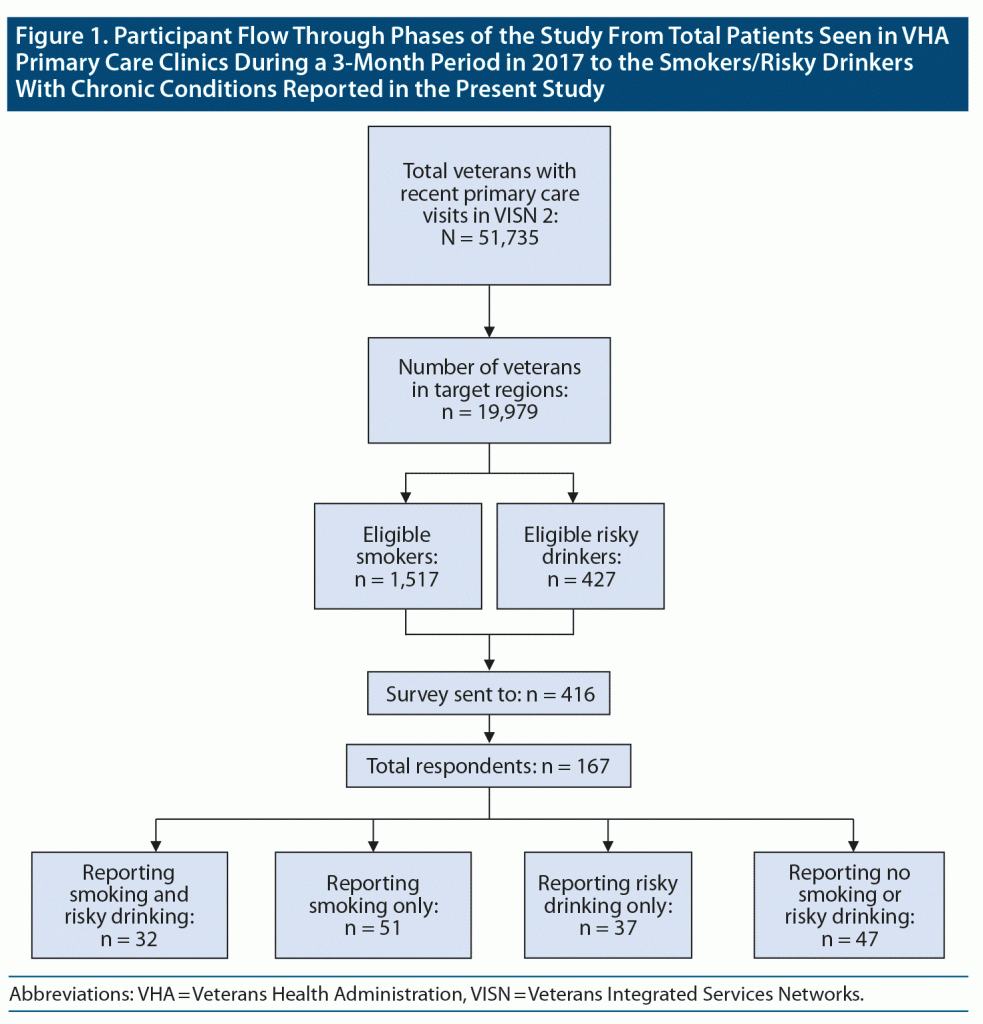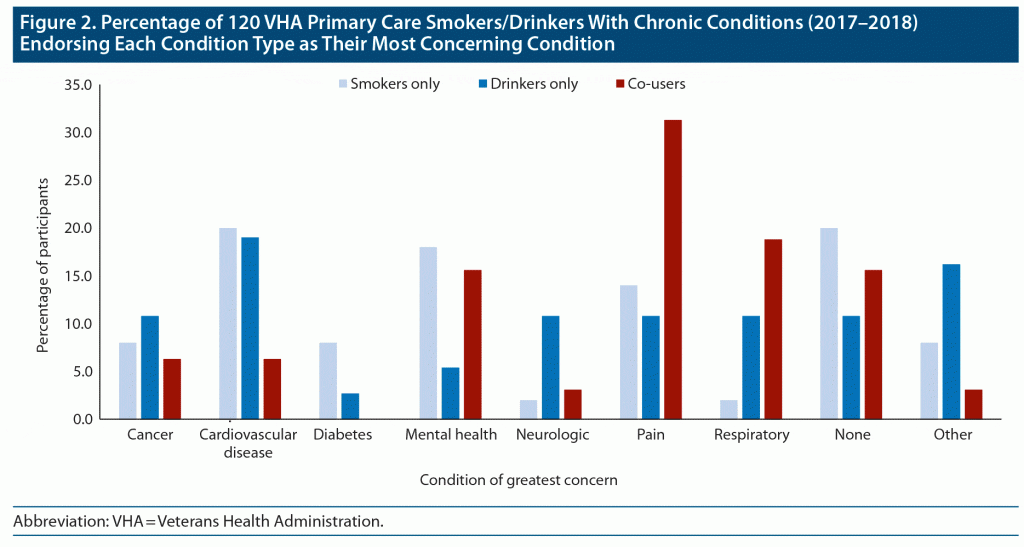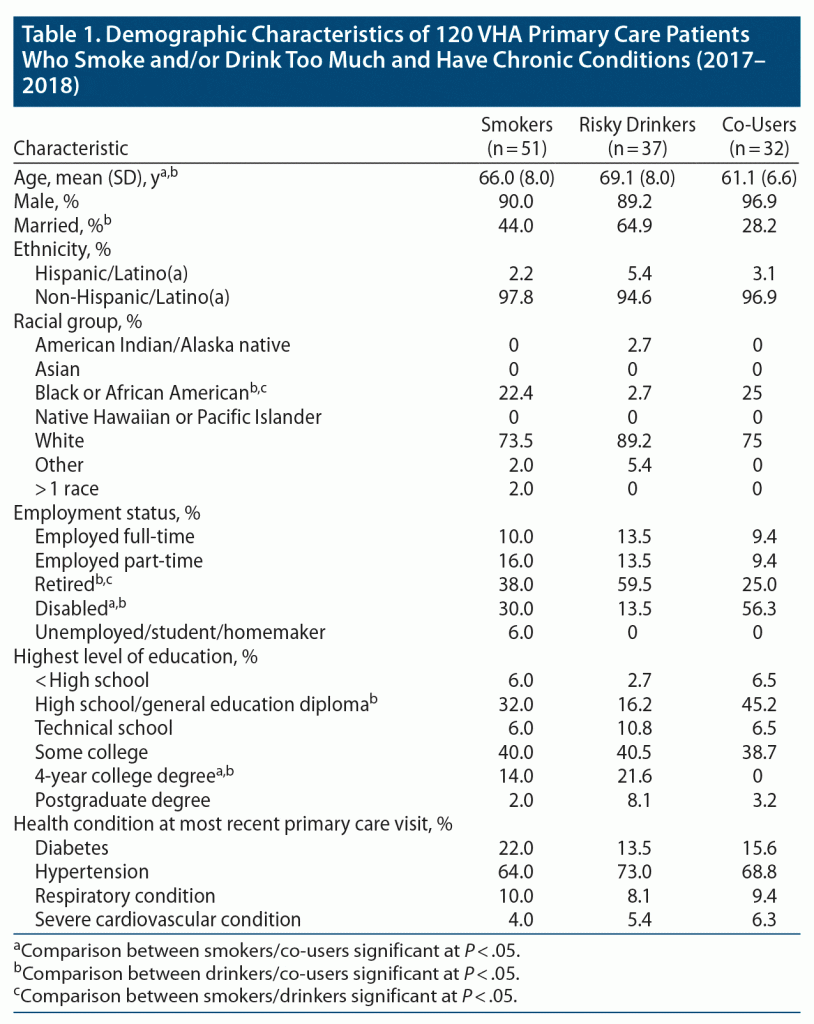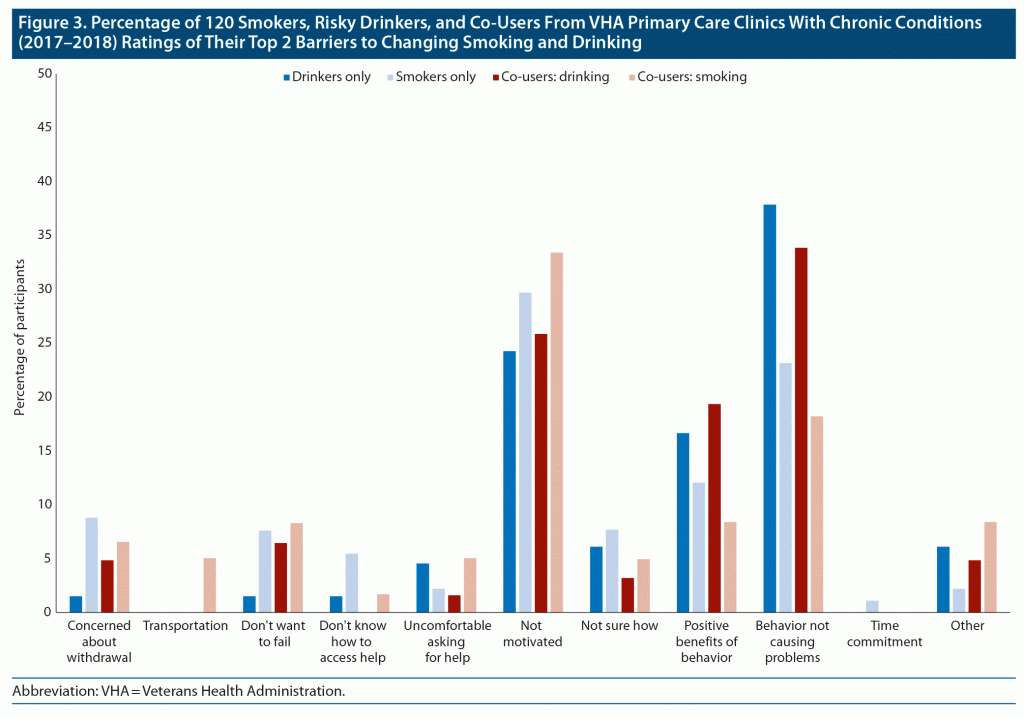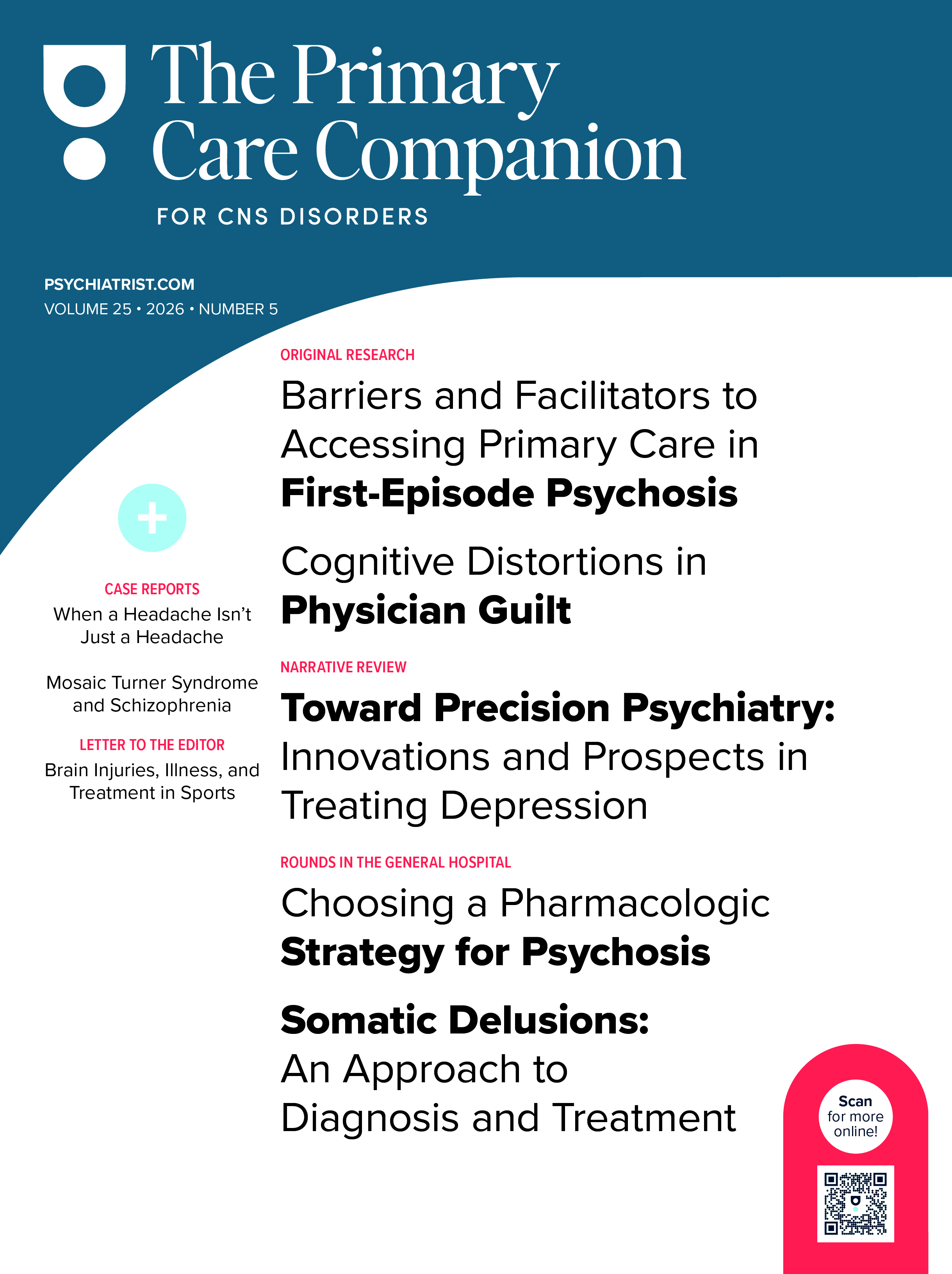ABSTRACT
Objective: Many individuals who smoke tobacco or consume alcohol at hazardous levels have chronic conditions that are caused or exacerbated by these behaviors. The objective of this survey study was to obtain data on the health care concerns, barriers, and readiness to change indicators of smokers/risky drinkers with related health conditions who have not responded to standard primary care interventions.
Methods: 167 participants (120 who reported current smoking or risky drinking or both) completed a 1-time mailed survey in 2017/2018. Participants were asked about smoking and drinking habits, physical health and impairments, health-related concerns, and barriers and readiness to change smoking and drinking.
Results: For smokers and drinkers, the most common health concern was cardiovascular related (22% and 19%, respectively), though co-users were more concerned about pain. The most common barriers to change were lacking motivation and belief that alcohol/tobacco was not impacting their health. For smokers and drinkers, stronger beliefs that smoking/drinking does not affect their health was associated with lower importance of changing.
Conclusions: Data from this study suggest that the main reasons patients report not changing are based on deficits in motivation and likely in information. In a group of patients who all have conditions that contraindicate smoking and risky drinking, their belief that their behaviors do not cause problems and that their health is not affected by their behaviors suggests a need for increased, focused education.
Prim Care Companion CNS Disord 2021;23(4):20m02836
To cite: Gass JC, Funderburk JS, Maisto SA. Barriers and pathways to changing smoking and risky drinking in primary care patients with chronic conditions who failed to respond to brief advice. Prim Care Companion CNS Disord. 2021;23(4):20m02836.
To share: https://doi.org/10.4088/PCC.20m02836
© Copyright 2021 Physicians Postgraduate Press, Inc.
aVA Center for Integrated Healthcare, Western New York VA Healthcare System, Buffalo, New York
bDepartment of Psychology, University at Buffalo, State University of New York, Buffalo, New York
cVA Center for Integrated Healthcare, Syracuse VA Medical Center, Syracuse, New York
dDepartment of Psychology, Syracuse University, Syracuse, New York
eDepartment of Psychiatry University of Rochester, Rochester, New York
*Corresponding author: Julie C. Gass, PhD, 3495 Bailey Ave, 116(N), Buffalo, NY 14215 ([email protected]).
Find more articles on this and other psychiatry and CNS topics:
The Journal of Clinical Psychiatry
The Primary Care Companion for CNS Disorders
CME Background
Articles are selected for credit designation based on an assessment of the educational needs of CME participants, with the purpose of providing readers with a curriculum of CME articles on a variety of topics throughout each volume. Activities are planned using a process that links identified needs with desired results.
To obtain credit, read the article, correctly answer the questions in the Posttest, and complete the Evaluation. This activity is free.
CME Objective
After studying this article, you should be able to:
- Educate patients about the link(s) between their smoking and/or risky drinking and specific problems resulting from associated health conditions
Accreditation Statement
The CME Institute of Physicians Postgraduate Press, Inc., is accredited by the Accreditation Council for Continuing Medical Education to provide continuing medical education for physicians.
Credit Designation
The CME Institute of Physicians Postgraduate Press, Inc., designates this journal-based CME activity for a maximum of 1.0 AMA PRA Category 1 Credit™. Physicians should claim only the credit commensurate with the extent of their participation in the activity.
Note: The American Nurses Credentialing Center (ANCC) and the American Academy of Physician Assistants (AAPA) accept certificates of participation for educational activities certified for AMA PRA Category 1 Credit™ from organizations accredited by the ACCME.
Release, Expiration, and Review Dates
This educational activity was published in August 2021 and is eligible for AMA PRA Category 1 Credit™ through August 31, 2023. The latest review of this material was August 2021.
Financial Disclosure
All individuals in a position to influence the content of this activity were asked to complete a statement regarding all relevant personal financial relationships between themselves or their spouse/partner and any commercial interest. The CME Institute has resolved any conflicts of interest that were identified. In the past year, Larry Culpepper, MD, MPH, Editor in Chief, has been a consultant for AbbVie, Acadia, Allergan, Eisai, Merck, and Takeda; has been a stock shareholder of M-3 Information; and has received royalties from UpToDate and Oxford University Press. No member of the CME Institute staff reported any relevant personal financial relationships. Faculty financial disclosure appears at the end of the article.
Many who smoke tobacco or consume alcohol at risky levels have comorbid chronic conditions that are worsened by these behaviors, such as chronic obstructive pulmonary disease, cardiac conditions, hypertension, and diabetes.1,2 For these individuals, primary care (PC) providers consider quitting or reducing comorbid smoking/risky drinking an emergent health priority.2 However, many do not respond to standard PC-based brief advice, as they are generally ambivalent about changing.3,4 Ambivalence prohibits individuals from attempting to make a change5 or seeking care.6 Although interventions for drinking/smoking are provided in specialty care settings, ambivalent patients are not likely to seek these services7 and treatments focus on change-ready patients.8 A more advanced, PC-based, brief intervention may be needed to help increase readiness to change in patients who do not respond to standard PC-based interventions.9,10
Interventions that resolve ambivalence and increase readiness to change, such as motivational interviewing (MI), have been shown to positively influence readiness to change, the provision of seeking treatment, and likelihood of making a quit attempt.11 Tailoring discussions by making them personally relevant to the patient, addressing specific barriers to changing, and linking impairment (eg, cannot walk upstairs due to breathlessness) to behavior seems most effective.12–15 Resistance to change in ambivalent patients can be improved via the use of tailored health messages,16 use of MI,17 and use of motivational enhancement therapy (MET; a structured brief treatment for patients considering substance use change).18 A 2014 meta-analysis19 examined MI in PC settings for health behaviors and found good evidence for MI leading to improved health outcomes such as substance use reduction. The authors19 suggested that involving providers more “highly trained” in MI in such interventions may improve efficacy, as does the provision of “booster calls” after the initial session, suggesting that standard PC interventions that do not include these elements may be lacking.
This study aimed to obtain data on primary health concerns, barriers to making changes, and what predicts motivation/readiness among smokers and risky drinkers with related conditions among patients who failed to respond to the standard brief advice. The patient sample was from the Veterans Health Administration (VHA), because it is the largest single health care system in the United States, and lifestyle behaviors resulting in increased health risk are of importance to the system and the United States in general.
METHODS
Study Design
This study was a 1-time, cross-sectional, mailed survey conducted in 2017/2018. Eligible participants received a cover letter, survey, and payment form in the mail. The survey took approximately 60 minutes. All methods were approved by the Western New York VA Healthcare System Human Subjects Institutional Review Board.
Remuneration
Participants received $30.
Setting
Participants were recruited from 3 VHA medical centers in western/upstate New York.
Participants
On the basis of previous mailed surveys conducted in our center,20 we anticipated approximately 25% would respond. To achieve a sample size of 100 participants, the survey was mailed to 416 potential participants.
Eligibility
Electronic medical record (EMR) data were pulled for patients who (1) lived in VHA catchment area 2 (VISN2, New York/New Jersey) and (2) had been seen in a VHA primary care clinic in May through July 2017. As shown in Figure 1, the pool was then reduced based on the following criteria: (3) screened positive on at least 2 consecutive annual primary care visits (ie, in 2016 and 2017) on VHA annual screeners for risky alcohol use or tobacco use (screeners were the Alcohol Use Disorders Identification Test-Consumption [AUDIT-C],21 on which 3 for women and 4 for men indicate a positive screen, and a 2-question yes/no tobacco use screen used by VHA22); (4) were coded at their most recent PC visit as having a chronic health condition in any of the following categories: cardiovascular diseases (CVDs) and risk factors (eg, hypertension), diabetes, liver diseases, gastroesophageal reflux disorder, and chronic respiratory conditions; (5) were at least 18 years old; and (6) were veterans. Random sampling was used to select 416 participants of the 1,944 to receive the survey.
Measures
Participants completed demographics and other self-report questionnaires. The survey branched into 2 sections with primarily identical questions referencing either smoking or alcohol use, allowing those participants to complete the section only if they responded “yes” to a dichotomous item asking about tobacco or alcohol use in the last year.
36-item Short-Form Health Survey (SF-36). The SF-3623 is a 36-item, patient-reported survey of patient health. We focused specifically on 3 subscales most likely to be related to the conditions of those in our sample: physical functioning (α = .93), role impairment due to physical condition (α = .84), and energy/fatigue (α = .86).24
Health concerns. Participants were asked the following question: “What are your medical or mental health diagnoses that you are most concerned about?” Space was provided to write up to 3 rank-ordered diagnoses. Only their top concern is reported here.
Fagerström Test for Nicotine Dependence (FTND) and cigarettes per day. The FTND25 is a 6-item nicotine dependence measure (α = .7). Scores ≥ 4 suggest nicotine dependence. Participants were asked how many cigarettes they smoke in an average day.
AUDIT. The AUDIT26,27 is a 10-item reliable measure of risky alcohol use (α = .80) and has high sensitivity and specificity (0.98 and 0.94, respectively) for detecting risky alcohol use.28
Importance and readiness rulers. Importance of changing and readiness to change were assessed using modified items from the Readiness Ruler.29 Participants were provided 10-point (1–10) visual analog scales and rated importance and readiness of quitting/changing drinking/smoking (1–3 = low, 4–6 = moderate, 7–10 = high).
Barriers to Cessation (BCS). The BCS30 is an 18-item scale measuring perceived barriers to changing smoking. The scale has good reliability (α values between .81 and .91). There are 3 subscales: addiction, external barriers, and internal barriers. One item (weight gain) was dropped from the current study, as it had poor reliability in previous research.30,31 For this survey, we used the BCS as written for smokers and adapted it for drinkers.
Top barriers to quitting/changing behavior. In addition to the BCS, participants were asked 2 questions about their perceived “primary” and “secondary” reasons for not making a change in drinking/smoking. The response options were developed by the authors based on several commonly cited barriers to alcohol/tobacco change (eg, lack of motivation, not knowing where to find support, etc).32 Figure 2 provides all response options. If participants selected “other,” there was a space provided to write in.
Beliefs about health. We developed 3 questions designed to assess participants’ beliefs about how smoking/drinking is related to their health that were rated on a 1 (strongly disagree) to 5 (strongly agree) Likert-type scale: (1) I don’t drink (smoke) enough to cause health problems, (2) Drinking (smoking) isn’t causing me any health problems, and (3) I don’t think that I am susceptible to health problems caused by drinking (smoking).
Statistical Methods
Missing data. In general, missing data (ie, if a patient skipped an item) were deleted pairwise; this was rare (< 0.5%) and random. For regression models (Aim 3), missing data were deleted listwise.
Data analysis. Data analyses were performed in SPSS 27.
Data reduction. All validated measures (SF-36, BCS, FTND, and AUDIT) were scored per the measures’ guidelines. For the 3 questions regarding beliefs about health, responses were averaged to produce 1 composite score ranging from 1 to 5.
Included participants. As noted earlier, to be included in the analyses, participants had to (1) check “yes” that they had smoked in the past month or (2) score 8 on the AUDIT. Data from participants who did not meet either cutoff were not included. Separate analyses were run for smokers, risky drinkers, and co-users.
Summary statistics. Descriptive statistics were calculated. For health concerns, all participant inputs were categorized by the first author into 1 of the following categories: cancer/cancer-related illnesses, CVDs, diabetic conditions, mental health, pain, neurologic conditions, respiratory conditions, none (if participants left the item blank or wrote “none”), and other. For their barriers to changing, text responses in the “other” category were coded by the first author to see if they fit into 1 of the other categories (ie, “I don’t want to” would be added to the “not motivated” category). For demographic characteristics (eg, age, race), 1-way analysis of variance (ANOVA) and χ2 statistics were performed to see if there were between-group differences.
Primary health concerns. Counts of each health concern of the above categories were conducted to obtain counts and percentages within each group.
Barriers to changing drinking/smoking. For both primary and secondary barriers, counts and percentages for each barrier were calculated.
Importance/readiness to change interrelationships. We tested several predictors for their effect on importance/readiness to change in separate linear regression main effects models using a forward entry method. Diagnosis (hypertension vs CVD/respiratory/diabetes), intensity of use (ie, AUDIT scores for risky drinkers, FTND/cigarettes per day for smokers), SF-36 subscales, BCS subscales, and beliefs about whether drinking/smoking affected their condition were predictors.
Comparison between drinkers/smokers on key variables. Independent samples t tests were conducted to determine if there was a significant difference between smokers and drinkers on the following variables: age, importance/readiness to change, BCS and subscales, SF-36 subscales, and health beliefs. Within co-users, 1-factor repeated measures ANOVAs (smoking vs drinking) were conducted.
RESULTS
Of 167 respondents (40% response rate, Figure 1), 47 were not included because they reported no smoking or risky drinking. Fifty-one participants reported smoking and 37 reported risky drinking in the past month. An additional 32 participants were classified as co-users. The most common coded condition at their PC visit was hypertension (68.3%, n = 82). Table 1 provides characteristics of participants in each group. Co-users were significantly younger than smokers or drinkers, were more likely to be disabled, and were less likely to have a college degree (all P < .05). Co-users were also more likely to have a high school degree/GED but no college and were less likely to be married than drinkers (all P < .05). Drinkers were less likely to be Black/African-American and were more likely to be retired than smokers or co-users (all P < .05).
The importance of changing drinking/smoking was moderate (means = 5.0–6.5, SDs = 2.7–3.3) across all groups, as were ratings of readiness (means = 4.8–5.3, SDs = 3.0–3.3). The only significant difference between smokers and risky drinkers was that drinkers reported a stronger belief that their drinking would not affect their health than smokers reported their belief that smoking would not affect their health (t = 4.7, P < .001). Co-users thought it was more important to change their smoking than their drinking (F = 7.3, P = .01), but were not more ready to change smoking than drinking (P > .05). Co-users also reported more total, addiction-based, and external barriers to changing smoking compared to drinking (F = 5.0, 6.2, and 5.0, respectively; P = .03, .02, and .03, respectively) and were more likely to think that their smoking negatively impacts their health than their drinking (F = 20.0, P = .00). These findings are summarized in Table 2.
Primary Health Concerns
As shown in Figure 2, CVDs were identified as the top concern in both the smoker (22%) and risky drinker (18.9%) groups. Co-users rated pain as being the top reported concern (31.3%). A sizable minority of participants across groups reported no health concerns (20% of smokers, 10.8% of risky drinkers, 15.6% of co-users).
Barriers to Changing Drinking/Smoking
Across all groups (Figure 3), the top barriers to changing were consistently “not motivated” (21.5%–29.7% of sample), “drinking/smoking is not causing me problems right now” (17.2%–34.92%), and “drinking/smoking has positive benefits” (8.4%–19.4%).
Importance/readiness to change interrelationships. In smokers, the model for predicting importance of changing was statistically significant (F10,35 = 2.24, P = .04, ηp2 = 0.38) and accounted for 22.5% of the variance (adjusted R2 = 0.225). Regarding individual predictors, only smoking health beliefs was significant (t = –2.11, P = .04), showing that a 1-point increase in smoking health beliefs corresponded to a 0.36-unit decrease in importance of changing (β = –0.36). No other predictors were significant (all P > .09).
For readiness to change in smokers, the overall regression model was statistically significant (F10,35 = 1.38, P = .23, ηp2 = 0.28, R2 = 0.07). The only significant individual predictors in the model were the BCS internal subscale (t = 2.05, P = .05, β = 0.33) and the external subscale (t = 2.56, P = .02, β = 0.67). All other predictors were nonsignificant (all P > .19).
Among risky drinkers, the model for predicting importance of changing was statistically significant and accounted for 45% of the variance (F9,26 = 4.18, P = .00, ηp2 = 0.59, R2 = 0.45). The AUDIT was significantly related to importance (t = 3.2, P = .00, β = 0.51). No other predictors were significant (all P > .12). For readiness to change, the overall regression model was significant and accounted for 25% of the variance (F9,26 = 2.3, P = .05, ηp2 = 0.44, R2 = 0.25). Only the health beliefs questionnaire was a significant individual predictor (t = –2.13, P = .04, β = –0.39). No other predictors were significant, Ps > .12.
DISCUSSION
Overall, smokers and risky drinkers with chronic related conditions in this PC patient sample reported that they were in the “moderate” range for readiness/importance to change. This generally did not vary between smokers and risky drinkers, though co-users thought that changing their smoking was more important than changing their drinking, which is consistent with previous research in primary care.33 While moderate scores are common in health care,34,35 they typically do not predict behavior change.
The reasons patients reported not changing were deficits in motivation and understanding how their behavior affects their health. Data suggest that patients tend to believe their behaviors are not causing problems and that their health is not affected by their behaviors, which implies a need for increased, focused education to fill in these educational gaps. Previous research suggests that this education should be self-relevant compared to more general information, as that is more effective.36,37 Of note, smokers were more likely to believe that smoking affected their health than drinkers. One potential explanation for this finding is related to health messaging—for the past 40 years, public health messaging has clearly and unequivocally stated that any smoking is harmful,38 while messages about alcohol use have been mixed and are less dichotomous.39
Patients in our sample reported many concerns, with a majority being most concerned about their cardiovascular health or pain. There is evidence that patients may not be aware that tobacco use and risky alcohol use have both been shown to be adversely related to cardiovascular health40,41 and pain.42,43 Therefore, it seems that a PC motivation-based intervention might include informing patients about the connections between their behavior and their cardiovascular health and pain. Previous research has shown that competing factors and competing distress, such as distress related to chronic pain, can prevent an individual from changing smoking or drinking. Thus, it is also suggested that as chronic pain is a continually growing concern in the VA, increasing options for and access to behavioral pain interventions could be beneficial to PC patients as well.
Participants also reported that the positive effects of alcohol/smoking are a barrier to changing. While our data do not specify what those positive effects are, the literature supports multiple possibilities, the most commonly cited being social benefits and temporary affective and stress relief benefits.44,45 Taken together, the data suggest that it would be beneficial for clinicians to ask about acute concerns such as pain, mental health, and social isolation to determine whether patients perceive smoking/drinking as helpful in coping with them and to explore possible alternatives if indicated.
Contrary to our hypotheses, more directly impairing conditions (ie, CVDs, diabetes, respiratory conditions) generally did not relate to greater ratings of importance/readiness to change drinking/smoking than the more common and less impairing condition of hypertension. Our data also showed that physical impairments and limitations did not predict increased readiness to change in the expected direction, as more role limitations predicted less importance/readiness to change. This result may be due in part to the educational deficits discussed earlier, ie, participants’ failure to associate their physical functioning with their smoking/drinking.
There were additional variables that seemed to relate to readiness to change/importance of changing. For risky drinkers, more hazardous drinking (ie, AUDIT scores) was related to greater importance to change their drinking. This result is consistent with previous literature showing that substance users whose related problems are more severe are typically more ready to change46 and with our finding that drinkers were more ready to cut down/quit if they experienced greater role limitations caused by alcohol. Although we did not find that smoking intensity related to importance/readiness among the smokers, we did find that if they believed that smoking is bad for their health, then they tended to report greater importance to change smoking. This result supports the notion that education about specific and individual health risks affected by a behavior can lead to more motivation to change that behavior. We also found that reporting more external barriers increased smokers’ readiness to change. Previous research has shown that smokers with more significant difficulty quitting tend to make more quit attempts,47 and our results may reflect that underlying process.
There are limitations to this study that should be considered. We could not locate a validated instrument designed to measure the constructs of interest in this study and therefore used an unvalidated questionnaire to measure beliefs about how smoking/drinking affects their health, as well as an unvalidated adaption of the BCS for drinkers, which increases the risk of measurement bias with unknown effects. Because measurement validation ensures that an instrument both reliably and validly measures what it is supposed to,48 there is a chance that the measures we used did not. Also, we were underpowered in regression analyses to evaluate relationships besides main effects due to our sample size. It is plausible that predictors may interact with one another, and we advise future researchers with a larger sample to use models including interaction terms. It is also important to consider our specific sample (ie, veterans from western/upstate New York), and that results may not generalize to nonveterans or those from other regions. Additionally, participants in this study were remunerated ($30) for participation, which may have skewed the sample toward those motivated to earn $30 (though it is important to note that this amount was approved by the institutional review board and found to carry low risk of coercion). Future research may attempt to address this issue by collecting similar data in an unpaid context. Finally, we did see demographic differences between groups that may limit some of the interpretations of the results.
On the basis of the literature and the data in the current study, future research should examine a brief PC-based intervention designed to target those patients at higher risk due to their failure to respond to brief advice and presence of comorbid conditions. Such an intervention could be based on the novel findings of this research: (1) that smokers, drinkers, and co-users are primarily concerned about their cardiovascular health and chronic pain; (2) that not thinking their behavior affects their health relates to lower motivation to change; and (3) that reasons for not changing are motivational and educational in nature. A potential effective intervention may be having a joint discussion in which the behavioral health and PC providers can utilize their specialized knowledge together to both (1) briefly discuss with the patient specific health concerns related to their chronic condition, (2) provide the patient condition-specific information regarding the link between smoking/drinking and their condition, and (3) discuss specific barriers to the patient making a change.
Submitted: October 13, 2020; accepted January 15, 2021.
Published online: August 19, 2021.
Disclosure of off-label usage: The authors have determined that, to the best of their knowledge, no investigational information about pharmaceutical agents or device therapies that is outside US Food and Drug Administration–approved labeling has been presented in this article.
Financial disclosures: The authors have no personal affiliations or financial relationships with any commercial interest to disclose relative to this article.
Funding/support: This study was supported by a VA Center for Integrated Healthcare Pilot Program grant in the amount of $14,577. Writing of this manuscript was supported in part by the Department of Veterans Affairs Office of Academic Affiliations, Advanced Fellowship Program in Mental Illness Research and Treatment, the VA Center for Integrated Healthcare, VA Western New York Healthcare System at Buffalo. Dr Gass is supported by the VA Office of Research and Development, Health Services Research and Development Career Development Award Program (grant K2 HX002610).
Role of the sponsor: The sponsor (VA Center for Integrated Healthcare) provided feedback on study design prior to funding this project.
Disclaimer: The views expressed in this article are those of the authors alone and do not represent the US Federal Government or the Department of Veterans Affairs.
Previous presentation: Portions of this study have been presented at the 2019 Annual Meeting at the Research Society on Alcoholism; June 22–26, 2019; Minneapolis Minnesota.
Additional information: The data underlying this article cannot be shared publicly due to it including protected federally regulated VHA-electronic medical record data. All procedures in this study were approved by the VA Western New York Healthcare System Institutional Review Board.
Clinical Points
- Focusing on the connections between smoking/drinking and cardiovascular health and chronic pain may increase the interest of patients in changing these harmful behaviors.
- Since many patients report not feeling that risky drinking and smoking are harmful to their health, providers should focus on the specifics of how these behaviors affect an individual patient’s health issues.
References (48)

- Shahoumian TA, Phillips BR, Backus LI. Cigarette smoking, reduction and quit attempts: prevalence among Veterans with coronary heart disease. Prev Chronic Dis. 2016;13:150282. CrossRef
- 2014 Surgeon General’s Report: The Health Consequences of Smoking—50 Years of Progress. Centers for Disease Control and Prevention. 2014. Accessed Mar 17, 2017. https://www.cdc.gov/tobacco/data_statistics/sgr/50th-anniversary/index.htm.
- US Department of Health and Human Services. National Institute on Alcohol Abuse and Alcoholism. Helping Patients With Alcohol Problems: A Practitioner’s Guide. Bethesda, Md: National Institute of Health; 2003.
- Dijkstra A, De Vries H, Roijackers J. Targeting smokers with low readiness to change with tailored and nontailored self-help materials. Prev Med. 1999;28(2):203–211. PubMed CrossRef
- Maisto SA, Conigliaro J, McNeil M, et al. Effects of two types of brief intervention and readiness to change on alcohol use in hazardous drinkers. J Stud Alcohol. 2001;62(5):605–614. PubMed CrossRef
- Beich A, Gannik D, Malterud K. Screening and brief intervention for excessive alcohol use: qualitative interview study of the experiences of general practitioners. BMJ. 2002;325(7369):870. PubMed CrossRef
- Levensky ER, Forcehimes A, O’Donohue WT, et al. Motivational interviewing: an evidence-based approach to counseling helps patients follow treatment recommendations. Am J Nurs. 2007;107(10):50–58, quiz 58–59. PubMed CrossRef
- Lo Coco G, Melchiori F, Oieni V, et al. Group treatment for substance use disorder in adults: a systematic review and meta-analysis of randomized-controlled trials. J Subst Abuse Treat. 2019;99:104–116. PubMed CrossRef
- Van Schayck OCP, Williams S, Barchilon V, et al. Treating tobacco dependence: guidance for primary care on life-saving interventions: position statement of the IPCRG. NPJ Prim Care Respir Med. 2017;27(1):38. PubMed CrossRef
- Varghese C, Nongkynrih B, Onakpoya I, et al. Better health and wellbeing for billion more people: integrating non-communicable diseases in primary care. BMJ. 2019;364:l327. PubMed CrossRef
- Magill M, Apodaca TR, Borsari B, et al. A meta-analysis of motivational interviewing process: technical, relational, and conditional process models of change. J Consult Clin Psychol. 2018;86(2):140–157. PubMed CrossRef
- Rollnick S, Heather N, Bell A. Negotiating behaviour change in medical settings: the development of brief motivational interviewing. J Ment Health. 1992;1(1):25–37. CrossRef
- Miller WR, Rollnick S. Motivational Interviewing: Helping people change. 3rd edition. Guilford Press; 2012.
- Miller WR. Motivational enhancement therapy manual: A clinical research guide for therapists treating individuals with alcohol abuse and dependence. US Department of Health and Human Services, Public Health Service, National Institutes of Health, National Institute on Alcohol Abuse and Alcoholism; 1995. https://pubs.niaaa.nih.gov/publications/projectmatch/match02.pdf
- Emmons KM, Rollnick S. Motivational interviewing in health care settings: opportunities and limitations. Am J Prev Med. 2001;20(1):68–74. PubMed CrossRef
- Hawkins RP, Kreuter M, Resnicow K, et al. Understanding tailoring in communicating about health. Health Educ Res. 2008;23(3):454–466. PubMed CrossRef
- Westra HA, Aviram A. Core skills in motivational interviewing. Psychotherapy (Chic). 2013;50(3):273–278. PubMed CrossRef
- Miller WR. Motivational enhancement therapy: Description of counseling approach. In: Boren JJ, Onken LS, Carroll KM, eds. Approaches to Drug Abuse and Counseling. Bethesda, Md: National Institute on Drug Abuse, NIH Publication; 2000:89–93.
- VanBuskirk KA, Wetherell JL. Motivational interviewing with primary care populations: a systematic review and meta-analysis. J Behav Med. 2014;37(4):768–780. PubMed CrossRef
- Buchholz LJ, King PR, Wray LO. Rates and correlates of disordered eating among women veterans in primary care. Eat Behav. 2018;30:28–34. PubMed CrossRef
- Bradley KA, Williams EC, Achtmeyer CE, et al. Implementation of evidence-based alcohol screening in the Veterans Health Administration. Am J Manag Care. 2006;12(10):597–606. PubMed
- Williams EC, Rubinsky AD, Chavez LJ, et al. An early evaluation of implementation of brief intervention for unhealthy alcohol use in the US Veterans Health Administration. Addiction. 2014;109(9):1472–1481. PubMed CrossRef
- Ware JE Jr, Sherbourne CD. The MOS 36-Item Short-Form Health Survey (SF-36), I: conceptual framework and item selection. Med Care. 1992;30(6):473–483. PubMed CrossRef
- Hays RD, Sherbourne CD, Mazel RM. The Rand 36‐Item Health Survey 1.0. Health Econ. 1993;2(3):217–227. PubMed CrossRef
- Heatherton TF, Kozlowski LT, Frecker RC, et al. The Fagerström test for nicotine dependence: a revision of the Fagerstrom Tolerance Questionnaire. Br J Addict. 1991;86(9):1119–1127. PubMed CrossRef
- Saunders JB, Aasland OG, Babor TF, et al. Development of the Alcohol Use Disorders Identification Test (AUDIT): WHO collaborative project on early detection of persons with harmful alcohol consumption‐II. Addiction. 1993;88(6):791–804. PubMed CrossRef
- Babor TF, Biddle-Higgins JC, Saunders JB, et al. The Alcohol Use Disorders Identification Test: Guidelines for Use in Primary Care. Geneva, Switzerland: World Health Organization; 2001.
- Daeppen JB, Yersin B, Landry U, et al. Reliability and validity of the Alcohol Use Disorders Identification Test (AUDIT) imbedded within a general health risk screening questionnaire: results of a survey in 332 primary care patients. Alcohol Clin Exp Res. 2000;24(5):659–665. PubMed CrossRef
- Center on Alcoholism. Substance Abuse, and Addictions (CASAA) Readiness Ruler. Albuquerque, NH: CASAA; 1995.
- Macnee CL, Talsma A. Development and testing of the barriers to cessation scale. Nurs Res. 1995;44(4):214–219. PubMed CrossRef
- Garey L, Jardin C, Kauffman BY, et al. Psychometric evaluation of the Barriers to Cessation Scale. Psychol Assess. 2017;29(7):844–856. PubMed CrossRef
- Rapp RC, Xu J, Carr CA, et al. Treatment barriers identified by substance abusers assessed at a centralized intake unit. J Subst Abuse Treat. 2006;30(3):227–235. PubMed CrossRef
- Aira M, Kauhanen J, Larivaara P, et al. Differences in brief interventions on excessive drinking and smoking by primary care physicians: qualitative study. Prev Med. 2004;38(4):473–478. PubMed CrossRef
- Whitlock EP, Polen MR, Green CA, et al; US Preventive Services Task Force. Behavioral counseling interventions in primary care to reduce risky/harmful alcohol use by adults: a summary of the evidence for the US Preventive Services Task Force. Ann Intern Med. 2004;140(7):557–568. PubMed CrossRef
- US Department of Health and Human Services. Healthy People 2010. 2nd ed. Washington, DC: U.S. Government Printing Office; 2000.
- Blow FC, Barry KL, Walton MA, et al. The efficacy of two brief intervention strategies among injured, at-risk drinkers in the emergency department: impact of tailored messaging and brief advice. J Stud Alcohol. 2006;67(4):568–578. PubMed CrossRef
- Flach SD, Diener A. Eliciting patients’ preferences for cigarette and alcohol cessation: an application of conjoint analysis. Addict Behav. 2004;29(4):791–799. PubMed CrossRef
- Durkin S, Brennan E, Wakefield M. Mass media campaigns to promote smoking cessation among adults: an integrative review. Tob Control. 2012;21(2):127–138. PubMed CrossRef
- Nicholls J. Everyday, everywhere: alcohol marketing and social media—current trends. Alcohol Alcohol. 2012;47(4):486–493. PubMed CrossRef
- Wartak SA, Friderici J, Lotfi A, et al. Patients’ knowledge of risk and protective factors for cardiovascular disease. Am J Cardiol. 2011;107(10):1480–1488. PubMed CrossRef
- McDermott MM, Mandapat AL, Moates A, et al. Knowledge and attitudes regarding cardiovascular disease risk and prevention in patients with coronary or peripheral arterial disease. Arch Intern Med. 2003;163(18):2157–2162. PubMed CrossRef
- Hahn EJ, Rayens MK, Kirsh KL, et al. Brief report: pain and readiness to quit smoking cigarettes. Nicotine Tob Res. 2006;8(3):473–480. PubMed CrossRef
- Egli M, Koob GF, Edwards S. Alcohol dependence as a chronic pain disorder. Neurosci Biobehav Rev. 2012;36(10):2179–2192. PubMed CrossRef
- White HR, Jackson K. Social and psychological influences on emerging adult drinking behavior. Alcohol Res Health. 2004;28(4):182–190.
- Aryal UR, Bhatta DN. Perceived benefits and health risks of cigarette smoking among young adults: insights from a cross-sectional study. Tob Induc Dis. 2015;13(1):22. PubMed CrossRef
- Williams EC, Kivlahan DR, Saitz R, et al. Readiness to change in primary care patients who screened positive for alcohol misuse. Ann Fam Med. 2006;4(3):213–220. PubMed CrossRef
- Leatherdale ST, Shields M. Smoking cessation: intentions, attempts and techniques. Health Rep. 2009;20(3):31–39. PubMed
- Reynolds CR, Suzuki LA. Bias in psychological assessment: An empirical review and recommendations. In: Graham JR, Naglieri JA, Weiner IB, eds. Handbook of Psychology: Assessment Psychology.
Please sign in or purchase this PDF for $40.
